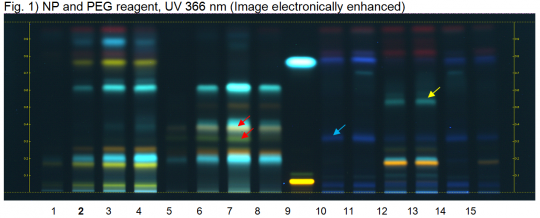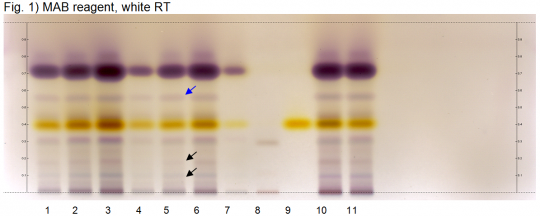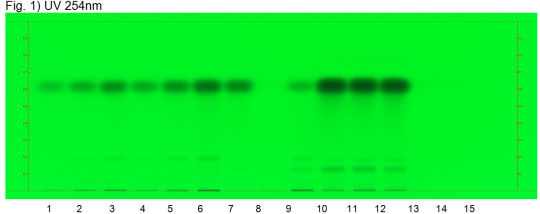Pimpinella anisum (fruit)
Contents |
Introduction
Macroscopic Entries
Microscopic Entries
HPTLC Entries
|
Anise (fruit) (Pimpinella anisum) Lane Assignments Lanes, from left to right (Track, Volume, Sample):
Reference Sample(s) Reference: Dissolve 3 mg of rutin in 1 mL of methanol. Dissolve 1 mg of caffeic acid in 1 mL of methanol. Stationary Phase Stationary phase, i.e. Silica gel 60, F254 Mobile Phase Ethyl acetate, formic acid, water 15:1:1 (v/v/v) Sample Preparation Method Sample: Mix 500 mg of powdered sample with 5 mL of methanol and sonicate for 10 minutes, then centrifuge or filter the solutions and use the supernatants / filtrates as test solutions. Derivatization reagent: NP and PEG reagent; Preparation NP reagent: 1 g of natural products reagent in 200 mL ethyl acetate; Preparation PEG reagent: 10 g of polyethyleneglycole 400 in 200 mL dichloromethane; Use: Heat for 3 min to 100°C, dip (time 0, speed 5) in NP reagent while still hot, dry, dip in PEG reagent. Detection Method Saturated chamber; developing distance 70 mm from lower edge; relative humidity 33% Other Notes Images presented in this entry are examples and are not intended to be used as basis for setting specifications for quality control purposes. System suitability test: Rutin: orange fluorescent zone at Rf ~ 0.07; Caffeic acid: light bluish fluorescent zone at Rf ~ 0.77. Identification: Compare result with reference images. The fingerprint of the test solution is similar to that of the corresponding botanical reference sample. Additional weak zones may be present. In the upper part of the chromatogram there are three prominent zones: a light blue zone at Rf ~ 0.88, a yellow zone at Rf ~ 0.76 and a light blue zone at Rf ~ 0.61. In the lower part of the chromatogram there is a sequence of three zones (yellow, light blue, yellowish) between Rf ~ 0.15 and 0.26. Right above the application position there is a yellow zone. Test for adulteration: In the middle of the chromatogram there are neither yellow zones at Rf ~ 0.32 and Rf ~ 0.38 (red arrows, Caraway fruit) nor a faint dark blue zone at Rf ~ 0.32 (blue arrow, Bitter Fennel fruit) nor a light blue zone at Rf ~ 0.53 (yellow arrow, Sweet Fennel fruit).
|
|
Anise oil (Pimpinella anisum) Lane Assignments Lanes, from left to right (Track, Volume, Sample):
Reference Sample(s) Reference: Dissolve 65 µL of anethole in 5 mL of toluene; Dissolve 15 µL of linalool in 5 mL of toluene; Optional: Dissolve 10 µL of anisaldehyde in 5 mL of toluene Stationary Phase Stationary phase, i.e. Silica gel 60, F254 Mobile Phase Toluene, ethyl acetate 93:7 (v/v) Sample Preparation Method Sample: Dissolve 50 µL of sample in 1mL of toluene Derivatization reagent: MAB reagent; Preparation: 0.25 g methyl 4-acetylbenzoate in a mix of 65 mL cold methanol and 5 mL sulfuric acid; Use: Spray, heat at 100 °C for 8 min Detection Method Saturated chamber; developing distance 70 mm from lower edge; relative humidity 33% Other Notes Images presented in this entry are examples and are not intended to be used as basis for setting specifications for quality control purposes. System suitability test: Anethole: yellow zone at Rf ~ 0.71; Linalool: violet zone at Rf ~0.29 Identification: Compare result with reference images. The fingerprint of the test solution is similar to that of the corresponding botanical reference sample. Additional weak zones may be present. The chromatogram of the test solution shows an intense purple zone corresponding to the zone of reference substance anethole, a yellow zone corresponding to reference anisaldehyde and a grey zone corresponding to reference linalool. Between the zones of anethole and anisaldehyde a grey zone is seen at Rf ~ 0.56 (blue arrow). Two other grey zones are detected below the zone of linalool at Rf ~ 0.10 and 0.18 (black arrows).
|
|
Aniseed (Pimpinella anisum) Lane Assignments Lanes, from left to right (Track, Volume, Sample):
Reference Sample(s) Reference: Dissolve 10 µL of olive oil in 1 mL of toluene. Dissolve 3 µL of anethole in 1 mL of toluene. Stationary Phase Stationary phase, i.e. Silica gel 60, F254 Mobile Phase Toluene Sample Preparation Method Sample: Mix 1 g of powdered sample with 10 mL of methanol and sonicate for 10 minutes, then centrifuge or filter and use the supernatants / filtrates as test solutions. Derivatization reagent: Phosphomolybdic acid reagent; Preparation: 5 g phosphomolybdic acid in 200 mL ethanol; Use: Dip (time 0, speed 5), heat at 120°C for 5 min. Detection Method Saturated chamber; developing distance 70 mm from lower edge; relative humidity 33% Other Notes Images presented in this entry are examples and are not intended to be used as basis for setting specifications for quality control purposes. System suitability test: Anethole: under UV 254 nm; a quenching zone at Rf ~ 0.61; Olive oil: after derivatization; a blue spot at Rf ~ 0.17 Identification: Compare result with reference images. The fingerprint of the test solution is similar to that of the corresponding botanical reference sample. Additional weak zones may be present. Under UV 254 nm the chromatogram of the test solution shows a prominent zone corresponding to the zone anethole. After derivatization a bluish zone corresponding to anethole and a zone corresponding to the zone at Rf ~ 0.17 obtained with the reference solution (olive oil) are seen. NOTE: After derivatization anise oil shows a blue zone at Rf ~ 0.81. No zone is seen at Rf ~ 0.17, but below this position two blue zones are detectable. Source: HPTLC Association [3] |
Other Points of Interest
Cite error: <ref> tags exist, but no <references/> tag was found


